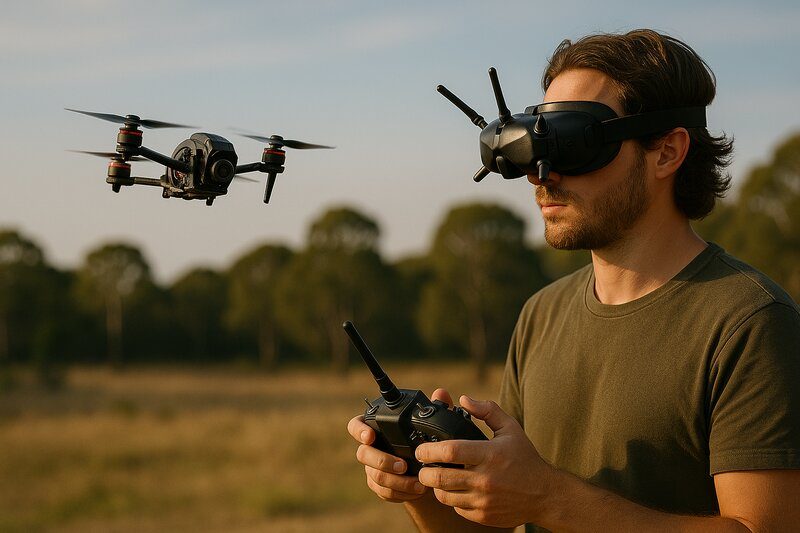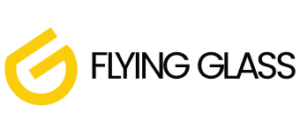Why FPV Drones Are Taking Over Australian Cinematography
If you’ve watched an ad or TV show lately and thought, how did they get that shot? – chances are, it was filmed with an FPV drone.
From the high-octane visuals in Red Bull productions to the cinematic sequences in Top Gear Australia, FPV drones (short for First Person View drones) are rapidly changing how aerial cinematography is done. At Flying Glass, we offer FPV drone services as part of our advanced drone cinematography offering, giving our clients dramatic, immersive footage that just can’t be captured any other way.
In this article, we’ll unpack what FPV drones are, how they differ from other drones, why they’re in such high demand, and how Flying Glass is uniquely positioned to deliver professional-grade FPV services across Australia.

What is FPV?
FPV stands for First Person View, referring to the way the pilot flies the drone – not by line of sight, but via a live video feed streamed from an onboard camera to their goggles. It’s like being in the cockpit of the drone, in real-time.
This allows for extremely precise, agile flying, making FPV drones capable of manoeuvres no traditional drone could safely perform. The resulting footage is dynamic, fluid, and exhilarating. FPV is particularly popular in:
- Racing drone competitions
- Cinematic commercials
- TV show segments
- Action sports coverage
- Architectural fly-throughs
At Flying Glass, we use FPV drones not for racing but to capture precision, speed, and perspective in commercial jobs where a traditional drone just won’t cut it.
FPV Drone vs Traditional Drone: What’s the Difference?
| Feature | FPV Drone | Traditional Drone |
|---|---|---|
| Flight Style | Manual, acrobatic | Stabilised, GPS-assisted |
| View | First-person via goggles | Third-person via controller screen |
| Footage | Dynamic, immersive | Smooth, cinematic |
| Pilot Skill | High | Moderate |
| Risk Level | Higher | Lower |
FPV drones require exceptional pilot skill. Unlike DJI drones with GPS lock and collision avoidance, FPV drones are flown manually – making them responsive, fast, and ideal for close-proximity flying.
At Flying Glass, we combine both types in most shoots – stabilised drones for wide cinematic angles, and FPV drones for high-energy cutaways.
How FPV Elevates a Project
Whether it’s a real estate ad, TV commercial, or event promo, FPV drones can:
- Add adrenaline and momentum to fast-paced sequences
- Create immersive first-person perspectives through structures
- Capture tight spaces or moving subjects from impossible angles
- Deliver one-take fly-throughs that feel like magic
Our clients often say, “That shot made the ad.”
Check out our showreel to see FPV sequences in Red Bull, Top Gear Australia and other recent projects.
Real-World Examples of FPV Drone Use
Red Bull
We’ve filmed extreme sports sequences requiring tight aerial choreography. FPV was the only viable way to keep up with the athletes while staying close enough to capture their intensity.
Top Gear Australia
We used FPV drones to chase vehicles at high speed through rugged terrain, maintaining a cinematic frame while flying through dust, wind, and tight corridors.
Real Estate Shows & Events
Fly-throughs of properties, showrooms, or venues are dramatically improved with FPV in shows such as Luxe Listings. From a single take, we can glide through doors, around staircases, and over crowds – all in one seamless shot.
Why Flying Glass Excels at FPV Drone Work
FPV is not something every drone operator can offer. It demands:
- Precise manual control
- Hardware customisation
- A deep understanding of aerodynamics and electronics
- Expert post-production workflows
At Flying Glass, we’ve built our FPV offering over years of professional experience. What sets us apart:
✔ CASA OONP Licence
Our Ongoing Operations Near People (OONP) exemption allows us to legally fly very close to people – something most operators simply can’t offer. This is essential for:
- Close-up performance shots
- Crowd flyovers
- Sports coverage
✔ Hybrid Workflow
We’re not FPV-only. We integrate FPV shots into broader productions that include DJI Inspire 3, Mavic 3 Pro Cine, and custom rigs. This allows a layered, cinematic approach to every job.
✔ Safety & Reliability
FPV flying is inherently higher-risk, but we’ve developed rigorous protocols, insurance coverage, and custom-built drones that minimise failure points. Every shot is planned and rehearsed – even the wildest-looking ones.
✔ Pilot Experience
Flying FPV at this level is closer to performance art than drone piloting. Our FPV operators train like athletes – flying every day, adjusting equipment, refining control.
This isn’t a side-offering. It’s what we do.
Types of FPV Drones We Use
- Cinewhoops – Small, ducted FPV drones for indoor flying and tight spaces
- 5-inch Freestyle Quads – Fast and agile, great for chase scenes and open spaces
- Long Range FPV – For sweeping shots across landscapes
- GoPro and Naked GoPro Builds -Lightweight drones with stabilised 4K footage
All our builds are maintained in-house, allowing fast turnaround and precision tuning.
Complexity & Creativity: What to Expect on Set
FPV drone filming isn’t point-and-shoot. Every job involves:
- Site Visit or Digital Twin Analysis
- Flight Path Mapping
- Line-of-sight spotters and safety checks
- Rehearsals and battery cycling
- On-the-fly adjustments based on light, wind, or subject movement
Because of the manual nature of flying, every flight is a unique take. It’s part of what gives FPV footage its magic -but also why you need experienced professionals like Flying Glass.
Common FPV Applications in Film & TV
- Chase scenes (cars, bikes, boats)
- Performance fly-bys (dance, concerts, stunt work)
- Architectural reveals (gliding through windows or up staircases)
- Event walkthroughs (one-take venue tours)
- Sporting events (skate parks, surf comps, track meets)
See it for yourself: Flying Glass FPV Showreel
Want to Learn FPV Flying? Start With RePL
If your team wants to bring FPV or drone cinematography in-house, it starts with proper training. Our partner SkyMedia Training offers CASA-certified Remote Pilot Licence (RePL) courses across Australia.
While FPV flying itself isn’t part of the basic RePL, having your licence allows you to legally fly and begin training with FPV gear.
FPV Drone Safety & Regulation in Australia
Flying FPV drones requires:
- Remote Pilot Licence (RePL)
- Operator’s Certificate (OC)
- OONP approval for close proximity to people
- Compliance with CASA safety standards
You must also:
- Keep flights within visual line of sight (VLOS) unless you have BVLOS approval
- Use spotters during FPV flights
- Stay outside restricted zones
Flying Glass handles all regulatory requirements, permits, and risk assessments as part of our service.
Why Agencies and Directors Choose Us
- Unmatched FPV capability
- Full production integration
- Trained crew, insured operations
- Experience in high-profile projects
We’re not just drone operators. We’re aerial cinematographers with a creative eye, safety-first mindset, and elite pilot talent.
If you need jaw-dropping FPV footage, you need Flying Glass.
Final Word: FPV Is the Future of Aerial Storytelling
The world of drone cinematography is evolving – and FPV is at the forefront. With the ability to fly indoors, chase moving objects, dive off cliffs, and create unforgettable one-take scenes, FPV drones are giving directors, producers, and agencies new tools to tell their stories.
Ready to elevate your project with FPV drones? Contact Flying Glass and let’s make something extraordinary.

